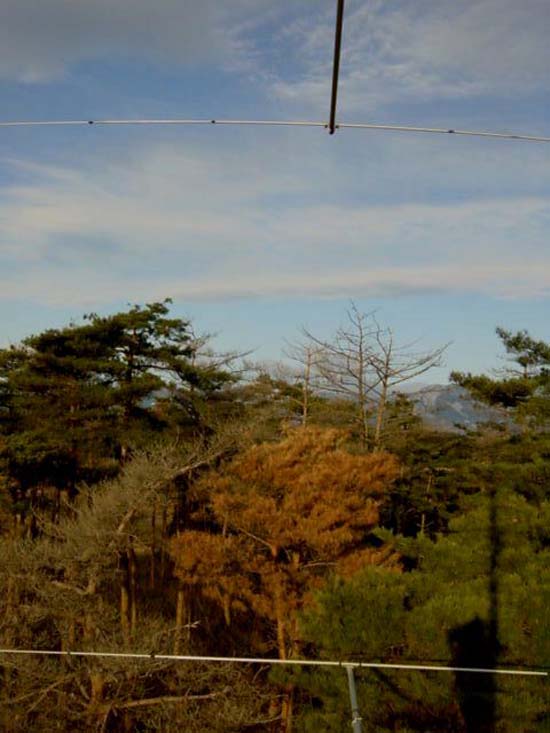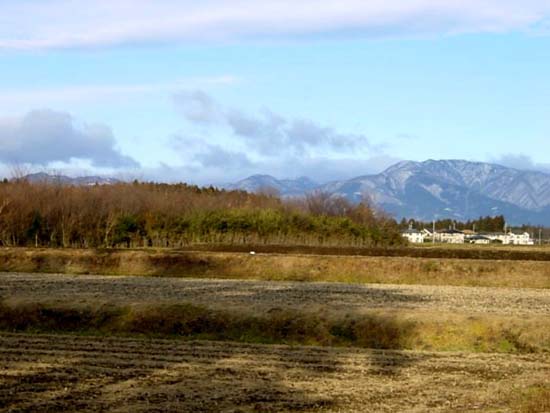Earth-Moon-Earth
Sound
Gallery
'JH1KRC'
 |
| Just after Mike succeeded to hear 15-meter EME (Big News).
Antennas are pointed to AZ 290 deg. Upper one is 6-ele. for 15m,
24-meters high, and lower one is 6el. for 20m. at 16-meter high.
|
 |
| Backyard of JH1KRC. Direction of AZ 290 deg. (in the direction
of the short path to Europe) is just over the bush. Farm yards and
low bushes spread in the area. There is no higher construction
before the mountains. |
THE 15-METER EME ECHOES RECEIVING TEST BY JH1KRC
JANUARY 2006
It is Jan. 08, 2006, that became a
special day to me in my ham radio experience.
When I worked
nine stations on 1296 MHz in the European window, the moon got
shadowy by the trees, so I decided to try an echo test on 15m which
had not been successful until that day. The moon was at EL 10.8
deg., and AZ 283.7 deg., around 1600Z (01am, local time), it was
unexpectedly easy for me that night to copy Q5 signal both in CW and
SSB, 21.250 MHz. I used a horizontally installed CL-15DX, a 6-el.
monoband Yagi, 1-WL boom length, manufactured by the Creative Design
Co., up 24 meters on a Skyneedle tower. It has the designed
radiation pattern of 18 dBi at 10 deg. elevation. A KW amplifier
with no less than 1 KW output, and IC-756PRO2 transceiver were also
used.
There was no noise on the band; very quiet. Outside
temperature was -6 deg. C., and the WX was very fine. The stable
echo was heard continually for ten minutes or so, until the moon at
EL 8 deg., close to the mountains. There was no fast QSB during this
after-mid night echo test on this band. Sorry but only a few seconds
of recording was made (because I didn't prepare it for this so easy
echo test) !
On the next day afternoon here Jan. 09, about an
hour after the moon rise at NA window, the local noise of S5
disturbed the echo test on 15m. JA1BAX with 6el. Yagi up 22-meter,
JA1JRK with 7el.quad up 30-meter and JH1RFR with 7el. yagi up 18m
joined in it, but no one detected the echo that afternoon, perhaps
because of high noise levels and the ionospheric activities in the
day time.
The next weekend, Jan. 14, my 15-meter echo test
was performed again. The moon at EL 12.5 deg., and AZ 291 deg., a
continual but unstable echoes began to appear at 2122Z (0622 JST).
WX was fine but just after heavy rain. Outside temperature was 5
deg. C., quite warm and humid! Again there was no snow noise over
the mountains in the direction of the moon. This time the echoes
were up and down in seconds, and in minutes cycles. It was different
QSB from that of last week. Unlike the other day, I guess this would
be the typical HF EME signals.
But still on the peak of the
signals, quite audible echoes were received even with 1KW
output.
Please listen to the wav. files I recorded, listed in
this JA-EME web-site, and get a surprise to the loud
signals.
I guess the path loss figure for the low band EME
might be reconsidered. Perhaps the reflection constant of the moon
(usually 0.07 for VHF/UHF) specially in the low frequencies might be
much better than VHF/UHF. And the band noise figure, the data taken
in the years of the high solar activities, might not be referable
for these years in the low solar activities. My radiation seemed
completely to penetrate the ionospheres without too much
losses.
Anyone can calculate the exact figures for my
experiments?
Many thanks to Alex, RU1AA and Peter, SM2CEW who
succeeded the recent 10m EME contact, for the good hints and ideas
to me, and to Yuzo JA1NKV, the president of the Creative Design Co.
for the well-designed beam antennas.
Listed wav. files
are:
EME 15m ssb 20060108, whistle in SSB mode, the receiver BW
2.4 KHz, recorded Jan. 08, 2006. 15m01142006-qrp10!,
15m01142006-qrp11!,, and 15m01142006-31qro for CW, the receiver BW
10 Hz, and 15m01142006-ssb33, the receiver BW 2.2 KHz, recorded Jan.
14, 2006.
73es, Mike Watanabe,
JH1KRC |
E-Mail

|

